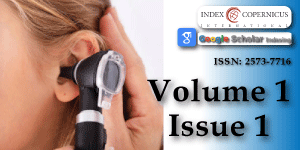Facial Paralysıs During Varicella Zoster Infectıon in a child
Main Article Content
Abstract
Introduction: Primary infection with varicella-zoster virus (VZV) results in chickenpox, characterized by viremia with a diffuse rash and seeding of multiple sensory ganglia, where the virus establishes lifelong latency. Herpes zoster is caused by reactivation of latent VZV in cranial-nerve or dorsal-root ganglia, with spread of the virus along the sensory nerve to the dermatome. Both entities have a benign clinical course in immunocompetent and young individuals. Although Herpes zoster virüs may result in Ramsey Hunt sendrom, it may rarely cause peripheral facial paralysis in the course of varicella.
Case report: A 4-year-old girl patient was admitted to the ear, nose, and throat clinic with a complaint of a rash over the body with vesicles and pustules a few days. She had left peripheral facial palsy about 2 days ago. In a general clinical examination, a few macular lesions, probably residues of vesicles, and fluid-filled blisters and pustules were observed on the back, chest, abdomen, upper, and lower limbs. She had remarkable left peripheral facial palsy. Her facial palsy was assessed as a grade II using the House-Brackmann Score. Otoscopic examination was normal and otalgia and auricular vesicle was absent. 1 mg/kg/day prednisone and 30 mg/kg/day acyclovir therapy were given to the patient due to the peripheral facial nerve palsy involvement of the VZV infection. Complete remission was achieved at 1 month after treatment.
Conclusion: Varicella-zoster virus (VZV) is one of eight herpes viruses known to cause human infection and is distributed worldwide. While the results of bell palsy are good, facial paralysis results during viral infections are severe. Cranial nerve involvement secondary to viral infection should be followed closely. The current standard of care for treatment is acyclovir and prednisone. Thus early treatment can be started in the face of developing complications and possible mortality and morbidity can be prevented.
Article Details
Copyright (c) 2017 Oghan F, et al.

This work is licensed under a Creative Commons Attribution 4.0 International License.
Yalaki Z, Öztürk A, Taşar MA, Dallar Y. Herpes Zoster Infections In Healthy Children. Cocuk Enf Derg. 2010; 4: 96-99. Ref.: https://goo.gl/HlC0Rs
Gershon AA. Varicella-zoster virus infections. Pediatr Rev. 2008; 29: 5-10. Ref.: https://goo.gl/nPFK3I
Gnann JW Jr. Varicella-zoster virus: a typical presentations and unusual complications. J Infect Dis. 2002; 186: 91-98. Ref.: https://goo.gl/g0vcty
Yilmaz C, Aksen HC. Severe neurological complications of chickenpox: Report of four cases. Eur J Gen Med. 2005; 2: 177-179. Ref.: https://goo.gl/deYDD5
Rama Rao G, Amareswar A, Kishan Kumar Y, Rani R. Isolated facial palsy in varicella. Indian J Dermatol Venereol Leprol. 2008; 74; 261-262. Ref.: https://goo.gl/esIOVl
Bozzola E, Tozzi AE, Bozzola M, Krzysztofiak A, Valentini D, et al. Neurological complications of varicella in childhood: case series and a systematic review of the literature. Vaccine. 2012; 30: 5785-5790. Ref.: https://goo.gl/UxYlfV
Danovaro-Holliday MC, Gordon EJ, Jumaan AO, Woernle C, Judy RH, et al. High rate of varicella complications among Mexican-born adults in Alabama. Clin Infect Dis. 2004; 39: 1633-1639. Ref.: https://goo.gl/xRUjo5
Amlie-Lefond C, Jubelt B. Neurologic manifestations of varicella zoster virus infections. Curr Neurol Neurosci Rep. 2009; 9: 430-434. Ref.: https://goo.gl/HbCusd
Riaza G´omez M, De la Torre Espi M, Bartolome SM, Molina Cabanero JC, Tamariz-Martel Moreno A. [Complications of varicella in children]. An Esp Pediatr. 1999; 50: 259-262. Ref.: https://goo.gl/o48gQs
Iwasaki H, Toda N, Takahashi M, Azuma T, Nakamura K, et al. Vestibular and cochlear neuritis in patients with Ramsay Hunt syndrome: a Gd-enhanced MRI study. Acta Otolaryngol. 2013; 133: 373-377. Ref.: https://goo.gl/gmTs90
Gunbey HP, Kutlar G, Aslan K, Sayit AT, Incesu L. Magnetic Resonance Imaging Evidence of Varicella Zoster Virus Polyneuropathy: Involvement of the Glossopharyngeal and Vagus Nerves Associated With Ramsay Hunt Syndrome. Journal of Craniofacial Surgery. 2016; 27: 721-723. Ref.: https://goo.gl/CnoEzp
Odemis E, Turkay S, Tunca A, Karadag A. Acute peripheral facial palsy during chickenpox in a child. J Pediatr Neurol. 2004; 2: 245-246. Ref.: https://goo.gl/w1UrVb
Muñoz-Sellart M, García-Vidal C, Martínez-Yelamos S, Niubó J, Fernández-Viladrich P. Peripheral facial palsy after varicella. Report of two cases and review of the literature. Enferm Infecc Microbiol Clin. 2010; 28: 504-508. Ref.: https://goo.gl/RxmHaJ





